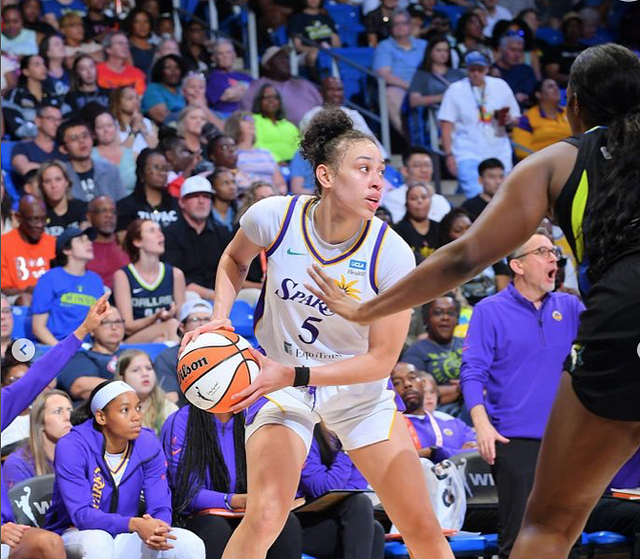LOS ANGELES SPARKS versus WASHINGTON MYSTICS
Crypto.com Arena
Los Angeles
July 2, 2024
It’s early summer, and the girls are down bad. The Los Angeles Sparks are in the midst of a seven-game losing streak; Cameron Brink, the star rookie who is arguably the team’s best player, is out for the season after tearing her ACL. I’m approaching the stupidly named Crypto.com Arena with three male friends (the worst way to attend a women’s basketball game, I know). We do not have high hopes for tonight’s game, but we’re here for the fanfare as much as the jump shots. After all, I like basketball because of its inherent drama — and girls have always done that better.
We are new admirers of the WNBA, but we’re not alone. The entry into the league by 2024 rookies like Brink, Chicago’s Angel Reese, and Caitlin Clark, who was taken first overall in this year’s draft by the Indiana Fever after leading her Iowa Hawkeyes over Reese’s LSU Tigers in the NCAA championship, has intensified mainstream media coverage. And still, conversations surrounding women’s basketball retain a slight, patronizing undertone, as if their subjects are women first and athletes second, overcoming their gender to do what men do.
Walking through Crypto.com, it’s clear that newcomers like us are only a small part of the WNBA ecosystem: we weave through well-seasoned Sparks loyalists, hopeful that the girls will snap their losing streak tonight. We make our way to our seats, delightfully close to the court. (I have only watched Dodgers games from what feels like a telescopic distance.) The tickets were an insultingly cheap $12 each, but seeing as most sports events have become cost-prohibitive, it’s encouraging to see women’s basketball made accessible to a wide range of fans. A close friend — who canceled on me tonight — jokes that WNBA games effectively double as lesbian bars, which charms me.
The audience roars as the Sparks get off to a strong start, leading early against the Washington Mystics. Purple-and-yellow jerseys are splashed across the arena — many donned by young girls who follow the action closely. Like at a Lakers game, the courtside promised its usual smattering of bizarre celebrity appearances, in this case Rosie O’Donnell and Leslie Jones. The Sparks maintain a comfortable lead for much of the game, largely due to Stephanie Talbot, playing in spite of a sprained ankle. By halftime, it seems the Sparks will finally snap their losing streak.
A team of young girls in effervescent purple uniforms emerges onto the court, spinning and dancing in tight choreography. A violet spotlight is projected over the crowd as the children continue with evident glee. It’s moments like these — watching my three male friends gape at an all-girls halftime show — that make me wonder why I don’t attend these more regularly.
There are few things in sports more enthralling than a comeback — even when it’s coming from the opposing team. After tying up the game, the Mystics score a triumphant win in the final two minutes. It’s spectacular. I love it, even though I am rooting for the Sparks. I think to myself, no one is guaranteed a win. Failure isn’t final. It’s the reason the WNBA is so spellbinding — you get to watch women even out the score in a game they were told was long gone.






